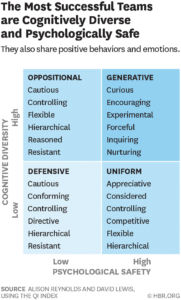
Imagine you are a fly on the wall in a corporate training center where a management team of 12 is participating in a session on executing strategy. The team is midway through attempting to solve a new, uncertain, and complex problem. The facilitators look on as at first the exercise follows its usual path. But then activity grinds to a halt — people have no idea what to do. Suddenly, a more junior member of the team raises her hand and exclaims, “I think I know what we should do!” Relieved, the team follows her instructions enthusiastically. There is no doubt she has the answer — but as she directs her colleagues, she makes one mistake and the activity breaks down. Not a word is spoken but the entire group exude disappointment. Her confidence evaporates. Even though she has clearly learnt something important, she does not contribute again. The group gives up.
What happened?
In an earlier article, “Teams Solve Problems Faster When They’re More Cognitively Diverse,” we reported our research findings that teams with high levels of cognitive diversity performed better on these kinds of challenges. In these groups, we observed a blend of different problem-solving behaviors, like collaboration, identifying problems, applying information, maintaining discipline, breaking rules, and inventing new approaches. These techniques combined were more effective than in groups where there were too many rule-breakers, or too many discipline-maintainers, for example.
But in the case of these 12 managers, they did show a cognitively diverse approach. So what happened? We returned to our data to find out. In this team, as well as other under-performing teams, we observed a smaller percentage of the group contributing, longer intervals between testing ideas, and greater repetition of the same mistakes.
The groups that performed well treated mistakes with curiosity and shared responsibility for the outcomes. As a result people could express themselves, their thoughts and ideas without fear of social retribution. The environment they created through their interaction was one of psychological safety.
Psychological safety is the belief that one will not be punished or humiliated for speaking up with ideas, questions, concerns, or mistakes. It is a dynamic, emergent property of interaction and can be destroyed in an instant with an ill-timed sigh. Without behaviors that create and maintain a level of psychological safety in a group, people do not fully contribute — and when they don’t, the power of cognitive diversity is left unrealized. Furthermore, anxiety rises and defensive behavior prevails.
So the question is, how do you establish and maintain psychological safety with a cognitively diverse group?
The Generative Organization
Over the last 12 months we asked 150 senior executives from different organizations across the world to rate their organizations in terms of cognitive diversity, psychological safety, and the extent to which they consider their organization able to anticipate and respond to challenges and opportunities, i.e. their adaptability. Not surprisingly, adaptability correlated very highly with high levels of both cognitive diversity and psychological safety. We called these organizations “generative,” and labelled the worse-performing organizations oppositional (high diversity, low safety), uniform (low diversity, high safety), and defensive (low in both).
We also asked the same 150 executives to choose five words (from a list of more than 60) that best described the dominant behaviors and emotions in their organization. To identify which behaviors correlated with the best- and worst-performing groups, we matched the chosen words with the levels of reported psychological safety and cognitive diversity. The table below shows the most common behaviors selected by each group:
 In the Generative quadrant, we find behaviors associated with learning, experimenting, and confidence. Together they facilitate high quality interaction. Interestingly, “forceful” appears here too, which at a first glance might seem surprising. Exploring this further, participants were identifying the assertive expression and vigorous analysis of ideas. “Forceful” therefore relates to having the confidence to persist in expressing what you think is important. Psychologically safe environments enable this kind of candour without it being perceived as aggressive. Note that we also see more positive emotions in the generative and uniform quadrants.
In the Generative quadrant, we find behaviors associated with learning, experimenting, and confidence. Together they facilitate high quality interaction. Interestingly, “forceful” appears here too, which at a first glance might seem surprising. Exploring this further, participants were identifying the assertive expression and vigorous analysis of ideas. “Forceful” therefore relates to having the confidence to persist in expressing what you think is important. Psychologically safe environments enable this kind of candour without it being perceived as aggressive. Note that we also see more positive emotions in the generative and uniform quadrants.
By contrast, in the other quadrants we find words associated with control and constraint. These behaviors are conspicuously absent from the Generative quadrant. We see more negative emotions as well.
The Behaviors That Count
We choose our behavior. We need to be more curious, inquiring, experimental and nurturing. We need to stop being hierarchical, directive, controlling, and conforming. It is not just the presence of the positive behaviors in the Generative quadrant that count, it is the corresponding absence of the negative behaviors.
For example, hierarchical behavior is cited as one of the top 5 dominant behaviors 40% of the time in the non-generative quadrants. It is only cited 15% of the time as a top behavior in the Generative quadrant. This is not because the organizations in the Generative quadrant have a flatter structure — hierarchy is a fact of organizational life — but because hierarchy does not define their interactions. We see controlling cited 33% of the time as a top behavior in the non-generative quadrants compared with only 10% in the generative quadrant. We see directive cited 24% of the time as top behavior in the non-generative quadrants compared to only 5% in the generative.
When we fail to foster a high quality interaction, we lose out on the benefit of discourse between people who see things differently. The result is a lack of deep understanding, fewer creative options, diminished commitment to act, increased anxiety and resistance, and reduced morale and wellbeing.
A psychologically safe environment ignites cognitive diversity and puts different minds to work on the bumpy and difficult journey of strategy execution.
How people choose to behave determines the quality of interaction and the emergent culture. Leaders need to consider not only how they will act, but as importantly, how they will not act. They need to disturb and disrupt unhelpful patterns of behavior and commit to establishing new routines. To lay the ground for successful execution everyone needs to strengthen and sustain psychological safety through continuous gestures and responses. People cannot express their cognitive difference if it is unsafe to do so. If leaders focus on enhancing the quality of interaction in their teams, business performance and wellbeing will follow.
About the authors
Alison Reynolds () is a member of faculty at the UK’s Ashridge Business School where she works with executive groups in the field of leadership development, strategy execution and organization development.
David Lewis () is Programme Director of London Business School’s Senior Executive Programme and teaches on strategy execution and leading in uncertainty. He is co-founder of a research company focusing on developing tools to enhance individual, team and organization performance through better interaction.

Thinkers50 Limited
The Studio
Highfield Lane
Wargrave RG10 8PZ
United Kingdom

Thinkers50 Limited
The Studio
Highfield Lane
Wargrave RG10 8PZ
United Kingdom

Thinkers50 Limited
The Studio
Highfield Lane
Wargrave RG10 8PZ
United Kingdom
| Cookie | Duration | Description |
|---|---|---|
| LANG | 9 hours | Linkedin set this cookie to set user's preferred language. |
| nsid | session | This cookie is set by the provider PayPal to enable the PayPal payment service in the website. |
| sp_landing | 1 day | The sp_landing is set by Spotify to implement audio content from Spotify on the website and also registers information on user interaction related to the audio content. |
| sp_t | 1 year | The sp_t cookie is set by Spotify to implement audio content from Spotify on the website and also registers information on user interaction related to the audio content. |
| tsrce | 3 days | PayPal sets this cookie to enable the PayPal payment service in the website. |
| x-pp-s | session | PayPal sets this cookie to process payments on the site. |
| __cf_bm | 30 minutes | This cookie, set by Cloudflare, is used to support Cloudflare Bot Management. |
| Cookie | Duration | Description |
|---|---|---|
| l7_az | 30 minutes | This cookie is necessary for the PayPal login-function on the website. |
| Cookie | Duration | Description |
|---|---|---|
| CONSENT | 2 years | YouTube sets this cookie via embedded youtube-videos and registers anonymous statistical data. |
| _ga | 2 years | The _ga cookie, installed by Google Analytics, calculates visitor, session and campaign data and also keeps track of site usage for the site's analytics report. The cookie stores information anonymously and assigns a randomly generated number to recognize unique visitors. |
| _gat_gtag_UA_10408481_1 | 1 minute | Set by Google to distinguish users. |
| _ga_ZP8HQ8RZXS | 2 years | This cookie is installed by Google Analytics. |
| _gid | 1 day | Installed by Google Analytics, _gid cookie stores information on how visitors use a website, while also creating an analytics report of the website's performance. Some of the data that are collected include the number of visitors, their source, and the pages they visit anonymously. |
| Cookie | Duration | Description |
|---|---|---|
| NID | 6 months | NID cookie, set by Google, is used for advertising purposes; to limit the number of times the user sees an ad, to mute unwanted ads, and to measure the effectiveness of ads. |
| test_cookie | 15 minutes | The test_cookie is set by doubleclick.net and is used to determine if the user's browser supports cookies. |
| VISITOR_INFO1_LIVE | 5 months 27 days | A cookie set by YouTube to measure bandwidth that determines whether the user gets the new or old player interface. |
| YSC | session | YSC cookie is set by Youtube and is used to track the views of embedded videos on Youtube pages. |
| yt-remote-connected-devices | never | YouTube sets this cookie to store the video preferences of the user using embedded YouTube video. |
| yt-remote-device-id | never | YouTube sets this cookie to store the video preferences of the user using embedded YouTube video. |
| yt.innertube::nextId | never | This cookie, set by YouTube, registers a unique ID to store data on what videos from YouTube the user has seen. |
| yt.innertube::requests | never | This cookie, set by YouTube, registers a unique ID to store data on what videos from YouTube the user has seen. |
| Cookie | Duration | Description |
|---|---|---|
| DEVICE_INFO | 5 months 27 days | No description |
| loglevel | never | No description available. |
| m | 2 years | No description available. |
Thinkers50 Limited has updated its Privacy Policy on 28 March 2024 with several amendments and additions to the previous version, to fully incorporate to the text information required by current applicable date protection regulation. Processing of the personal data of Thinkers50’s customers, potential customers and other stakeholders has not been changed essentially, but the texts have been clarified and amended to give more detailed information of the processing activities.